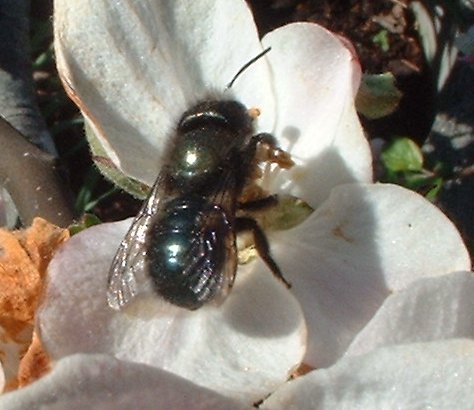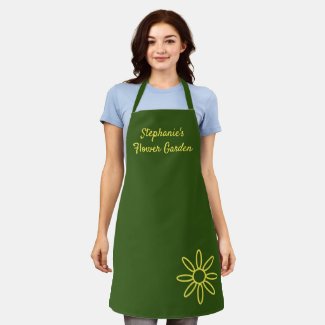Attracting and keeping orchard mason bees
Copyright National Lilac Publishing, LLC
Plan for Spring Pollination with Mason Bees
by Barbara Berst Adams A version of this article first appeared as a sidebar to a feature article in AcresUSA.
The metallic bluish black North American native mason bee (Osmia lignaria) can be a valuable springtime pollinator. Many eco-farmers like to attract them in various ways, or even buy mason bees to release within their crops, and report far more fruits on their crops after mason bees have lived in the area. These bees don’t make honey and rarely sting as they are considered quite docile. A bit smaller than honeybees, they don’t live in hives. They are also called orchard mason bees, blue orchard mason bees, and blue mason bees.

Photo: Red58bill under the creative commons attribution 3.0 license
According to Lisa Novich of Knox Cellars in Washington State which has sold mason bees and their supplies since 1990, the vertical territory of mason bees extends from USA southern borders in California and Arizona all the way up across the border into Canada. “They are spread across the country from coast to coast,” Novich says about their horizontal territory, “with an eastern and western subspecies. Bees have been transported back and forth for so many years, however, that those original subspecies may no longer exist. They are not native in the steamy southern states particularly Florida, Lousiana, and Mississippi. At extreme high elevations they also don't exist.”
As far as mason bee pollination, there is a very active period during specific times in the spring. “Both males and females pollinate,” says Novich. “However, in the mason bee world it's almost all about the girls. The males emerge first in the spring and they do a little foraging in the blossoms to get nectar for their own meals. This rustling around in the blossoms does effect some pollination but once the girls have emerged and the males have completed their mating duties, the males all die and the rest of the spring is all females. They collect pollen to provision their nesting chambers. This pollen is the protein source for their eggs as they develop through their different stages of egg, larvae, pupae and finally into adult bees. This food provisioning work is what causes the vast majority of pollination in our gardens. So with mason bees you want as many females as you can get!”
The mason bee life cycle has been described as short, fast and furious, and all adults may be finished with their cycle by June or earlier, depending on the area of the country, as well as variations within the weather during any given year. When asked when mason bees first emerge, Novich says, “This happens in mid January or early February in the warm winter parts of the country and as late as the first of May in colder areas. Here in western Washington we generally start seeing masons in early March. We then see masons flying around, pollinating our gardens, and laying eggs for about two to two and 1/2 months. At the end of this time (around late May or the first of June in western Washington) all the adults die off and the eggs they laid spend the summer in their nest holes developing into adult bees. They then spin a cocoon around themselves, still in that same hole, and hibernate there all winter. In the spring, they emerge, mate, and start the cycle again. So with masons, we see three months of frantic activity and then 9 months of nothing at all.”
While mason bees are solitary and don’t make nor seek out hives to thrive in social groups, multiple bees are often seen making nests close to each other. Novich explains that they have been classified as solitary gregarious bees, “which means in our terms,” she says, “that they live the New York Condo kind of lifestyle. They jam close together, but like New York neighbors, they don't interact with the folks next door very much.”
Attracting mason bees
Whether the farmer wants to purchase mason bees or just attract nearby ones, providing appropriate pollen sources is very important. Mason bees stay nearby and remain healthier if they have enough pollen sources for their entire short lifespan for both genders. Make sure there is a diversity of pollen sources both before and after the blossoming of your main crops that you want them to pollinate, but avoid allowing supplemental pollen sources to over compete with the actual crops you want them to visit. Orchardists and other growers have used white and red clover, dandelion, crane's bill, radish and mustards amidst their orchard floors or surrounding their crops. Chinese winter honeysuckle (Lonicera fragrantissima) is believed to be a good blossom source often blooming before some main crops, while Tatarian honeysuckle (Lonicera tatarica) may be a good choice for after crop bloom. However, because all climate regions are different, your own local cooperative extension agent may be able to let you know at what point these supplemental pollen plants bloom in comparison to the crop or crops you’re seeking to pollinate. If farmers want new mason bees to emerge next spring from the nests they’re building this spring, a nearby pollen source has to continue to supply the females until their life cycle ends.
Another way to attract and keep mason bees is to put up appropriate mason bee homes, either homemade or purchased. Females seek cavities in the shape of long thin holes, straws or tubes, sometimes found naturally in nearby wood, in which to prepare for the next generation of bees to emerge next spring.
As soon as the female chooses her nesting tubes, she collects pollen, then forms a ball of pollen and nectar which she places in the very back of the hole. This becomes the food source on which she lays her eggs, then makes a partition with mud so she can start the process over again until the hole is filled with these egg cells. She finishes by capping off the hole with more mud. Her life cycle is complete and she dies once her egg-laying mission is finished. The eggs inside will become next spring’s active mason bees.
“One female will mark a straw or hole with a phermone and she will be the only one to use that hole,” Novich says. “When she fills it up, she will move to a nearby empty hole and start filling that one. In a typical mason unit there will be multiple females all with multiple individual straws. Two females won't share one hole under normal circumstances.”
People have found numerous ways to make mason bee homes. One of the simplest attempts has been filling a clean, empty food can with drinking straws glued to the bottom, then mounting the can horizontally. Others fill clean, old milk cartons with straws in the same way. When paper drinking straws are used, most agree this delicate housing structure needs extra protection from the elements. While plastic straws are stronger and more weather proof, they don’t “breathe” and some mason bee enthusiasts feel they’re more prone to mold and disease. Besides, in an attempt to regenerate the planet, items like plastic straws are phasing out.
Untreated wooden blocks can also be drilled with holes to make more sturdy nesting sites for mason bees. One simple example is drilling a piece of 4-inch by 6-inch lumber with 5/16-inch diameter holes on ¾-inch centers. Regardless of the size of the lumber, the holes can be from four to eight inches deep. Holes with a shorter length are believed to produce more males. Don’t drill all the way through to the back, but rather, to a half inch or so from the back. Secure it at least three feet high.
Keep in mind that, depending on your location, there may be other native bees (which are also possibly valuable to the farmer) besides the mason bee which may be attracted to this type of home, such as red mason bees. Also, while mason bees may be somewhat flexible when choosing nesting holes, certain diameters may encourage more female than male bees to be produced, and as we know, females are the most active pollinators. Once again, contact your local cooperative extension agent or a mason bee professional to see if they know the ideal size for holes to attract the type of mason bee in your area.
Purchased mason bee homes are also available for sale. They may offer extra features such as being easier to clean from year to year, or extra protection from severe climate or predators entering the holes.
Finding the best location for the mason bee house is very important. Some examples include under an overhang that protects from heavy rain, hail or snow. In some climates, too much sun later in the summer can overheat the developing bees inside the nests. So in this case, an ideal location might face east, providing morning sun but protecting from the hot, direct afternoon summer sun. In areas with cooler summers, though, people leave their mason bee homes in direct sun all day without any problems.
After the females are finished filling and plugging the nests and all activity has stopped, they can either be left where they are all winter, or brought to a more sheltered area to make sure winter winds, ice and wild animals don’t dismantle or destroy the nests. If this is done, they must be restored to their original location in plenty of time before the first possible emergence. Remember though that cold winter temperatures are part of the necessary dormancy and development cycle, so a warm area such as a greenhouse wouldn’t be an appropriate winter storage area.
A mud supply is one more thing you can provide your mason bees besides pollen and housing during the nesting season. Though they are resourceful in finding the supply of mud needed to partition each egg cell, a safe and ample supply of mud within their territory during their short lifetimes can help them complete their mission. A small, bare, area of clayish soil kept moist throughout the active season can be ideal. If it’s difficult to keep an area like this properly wet because the surface water absorbs too quickly, a tray or shallow tub can be devised to hold mud. Make sure the supply isn’t pure compost or too sandy to give it the sticking ability it needs for the females to make proper plugs.
The extremely active rate at which the females must gather nectar and pollen in spring may explain why spring blossoming crops do so well when mason bees are present. They don’t have the luxury of staying inside the hive when the weather isn’t ideal outside. Rather, they pollinate regardless of the spring weather, and have special hairs on their abdomen that are exceptional at picking up pollen. Although opinions and locations differ, growers state that mason bees don’t fly much further than 300 yards from home. Many others, in fact, observe the bees only flying out within a radius of 100 yards from where they were hatched. They have helped increase production of raspberries, blueberries, apples, apricots, peaches, cherries, cranberries, strawberries and other spring blossoming fruits. They also visit spring blossoming herbs, flowers and various garden crops.
You may also enjoy
Backyard garden honeybee hive alternative for pollination, honey and beeswax







